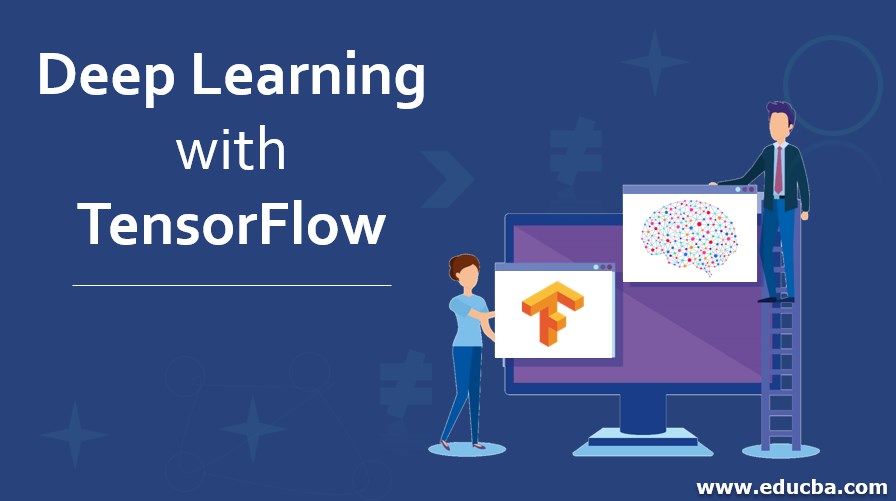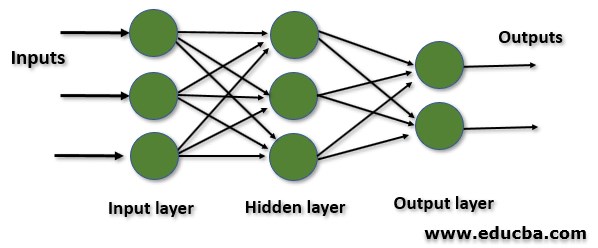Updated June 12, 2023

Introduction to Deep Learning with TensorFlow
Deep Learning in TensorFlow has garnered a lot of attention over the past few years. Artificial intelligence (AI) has a subset called deep Learning that mimics the neurons in the human brain. Deep Learning Models create a network similar to the biological nervous system. It imitates the human thinking process. Deep Learning is the collection of nodes where each node acts as a neuron. The hype about deep Learning is pretty dense.
Why do we need this?
We need Deep Learning Models to solve complex problems like speech detection, image recognition, etc. Regarding accuracy, deep learning models are best when trained with huge amounts of data. Feeding deep learning models with unlabeled and unstructured data still draws insights from the data. Walter Pitts and Warren McCulloch created the first computer model based on neural networks which mimic the human brain in 1943. The Decision of the deep learning models is based on the Input to the nodes. This Neural Network has Input Layers, Hidden Layers, and Output Layers. The Input is fed to the Model through input layers, hidden layers perform the processing, and the output is generated at the output layers.
Importance of Deep Learning with TensorFlow
“The Deep Learning Market will grow to reach a value of $1,772.9 million by 2022 “is anticipated by MarketsandMarkets. It is easy to build a Neural network, i.e., Deep Learning models, without worrying about the underlying algorithm with the help of an interface, library, and tool known as a Deep Learning Framework.
Different Deep Learning Frameworks are:
- Caffee
- Keras
- Microsoft Cognitive Toolkit
- MXNET
- DeepLearning4j
- Chainer
- TensorFlow
Different Frameworks are built for different purposes. But among all these frameworks, TensorFlow is a highly flexible system architecture. Many Big giants like Facebook, Google, Deepmind, Nvidia, Airbnb, Lenovo, etc., are now adopting TensorFlow. The top applications of TensorFlow are Speech Recognition Systems, Autonomous Cars, Summarization of Text, Sentiment Analysis, Image Recognition, Video Recognition, Tagging, Handwriting Recognition, and Forecasting. TensorFlow supports Programming Languages such as Python, R, and C++ and is available on mobile and desktop.
TensorFlow builds models using Data Flow Graphs, an open-source Artificial Intelligence Library. Why is it called TensorFlow? It works on Tensors (n-dimensional array) and flows (as data goes in and after processing comes out of the network). Each node in the neural network is a mathematical operation, and edges represent a data array (n-dimensional). TensorFlow was released by Google in the year 2015. TensorFlow is a powerful library for implementing big machine learning and deep learning projects.
Steps of TensorFlow Algorithm
The basic steps of the TensorFlow algorithm are as follows:
1. Data is Imported/Generated: TensorFlow models depend heavily on the huge amount of Data. Either you can import your dataset, or TensorFlow also comes with a collection of datasets ready to use.
- Type this command to check out available datasets in TensorFlow.
Code:
import TensorFlow as tf
import TensorFlow_datasets as tendata
#This command will generate a list of datasets available in the TensorFlow
print(tfds.list_builders())
2. Data Normalization or Transformation: If the data is not in the appropriate forum. Batch normalization is the command approach used to normalize data in TensorFlow.
3. Set the Parameters of the Algorithm: For e.g., the number of Iterations, Learning rate, etc.
4. Set and Initialize the Variables and Placeholders: These are two essential programming Elements of TensorFlow. Variables hold the state of the graph, and placeholders are used to feed the data in the graph at a later date.
5. Create Model Structure: What operations will be performed on the data is defined.
6. Define the Loss Function: It calculates the difference between predicted values and actual values. It tells how well your Model is trained and is used to evaluate the output.
7. Train Model: Initialize computational graph and create an Instance of a graph. Feed data into the Model with the help of placeholders and let TensorFlow do the rest of the processing for better predictions.
8. Evaluate the Performance: Evaluate the Model by checking with new data.
9. Predict the Outcome: Check your Model on new and unseen data.
To better visualize the Model, TensorFlow provides Tensorboard. It helps us to visualize any statistics of the neural network and debug and optimize them. You can check what happens in the code, and it will give you a detailed understanding of the inner working. You can fix problems very quickly with the help of this tool.
Tensorboard provides five types of visualizations:
- Scalars
- Images
- Audio
- Histograms
- Graphs
The summary function of the TensorFlows gives us a detailed summary according to the specified format. We use the session function to allocate resources, hold intermediate results and variables, and execute graphs or part of a graph.
Advantages
Given below are the advantages mentioned:
- It is open-source and free to use.
- Google, a major backer, ensures frequent software releases, quick updates, and good performance.
- It provides Tensorboard, which allows us to visualize graphs and see the inner working.
- Without any hardware support, you can perform high-level computation on your laptop. TensorFlow runs on CPU, GPU, desktop, servers, and mobile platforms. They are scalable as well.
- Debugging the subpart of the graph is easy using TensorFlow.
Scope in Deep Learning in TensorFlow
- Deep Learning is creating a huge impact on our lives.
- The skills required to start your career in deep Learning are Modelling Deep learning neural networks like CNN, RNN, LSTM, ADAM, Dropout, etc., and a good understanding of the probabilistic methods.
- According to Glassdoor, the average salary of machine Learning engineers is 8LPA. The average salary for deep learning engineers will be higher than for machine learning Engineers.
- TensorFlow provides excellent functionalities compared to the deep learning library.
- As big tech giants are adopting this technology, the need for TensorFlow experts has already been raised in the market.
Conclusion
In this article, we saw the basics of TensorFlow, its advantages, and its applications. Given the above facts about TensorFlow, if you have a strong desire to learn AI, you should kick-start your career now.
Recommended Articles
This is a guide to Deep Learning with TensorFlow. Here we discuss the introduction, importance of deep Learning with TensorFlow, scopes, advantages, and steps in the algorithm. You can also go through our other related articles to learn more–

